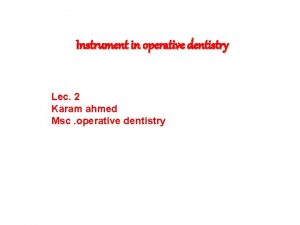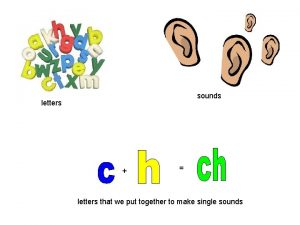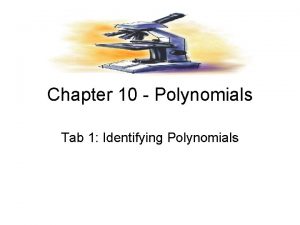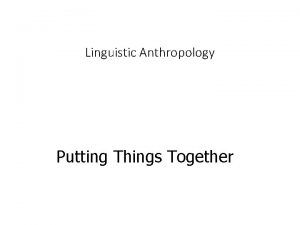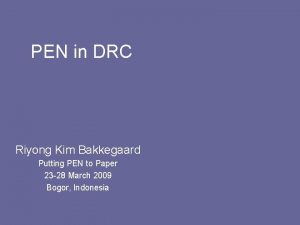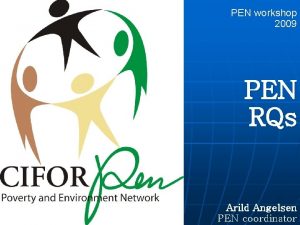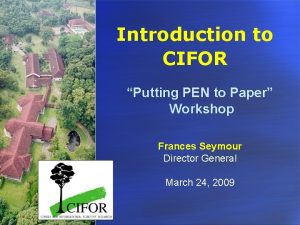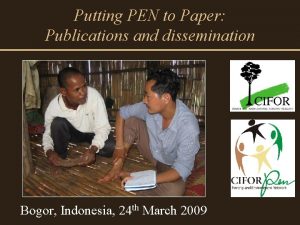PEN Partner India Putting PEN to Paper PEN









- Slides: 9

PEN Partner (India) ‘Putting PEN to Paper’ PEN workshop, Bogor 23 rd – 28 th March 2009 Monika Singh University of British Columbia monikaxing@gmail. com

Context n n Location: India, Southern Gujarat (Western India), tropical wet and dry climate with tropical dry deciduous forest Study area is approx 100 sq km

Context Number villages sampled: Initially 3, later 2 Total population sampled: Initially 200, later 125 Total households (in 2 villages): 203 Average number people per household: 5. 4 Key sub-dimensions Village Forest area Distance from road Management Initiated by Kevdi Proximity to large forest Far from road head FD initiated (earlier it was a non-JFM village) Gamtalav Medium forest Near the road FD initiated Sakwa Medium forest Little distance to main road; connected with motor-able road NGO initiated

Household income sources Main contributions for household income Subsistence (Own use): n n Agriculture - crops Forest other environmental (Mainly Fish) Cash: n n n livestock wage business and services other environmental (Fish) Agriculture (Lesser amount) Difference in villages: n n Interior village forest use is more regular (Fuel-wood) Accessible village has higher income from livestock and agriculture

Key forest and environmental products Forest products: n Regular use: Fuel-wood, fodder, mud (subsistence) n Seasonally available: leaves, bamboo (both subsistence and cash) Environmental income: n Fish (seasonal; subsistence and for cash) (Found only in the interior village as there is a dam and small stream) Pricing: n As per household/respondent n Incase it is not sold, price they are willing to pay

Income sources and seasonality Seasonality: n Q 1 (Feb-April): Higher dependence on livestock, fish and forest, medium for agriculture n Q 2 (May-July): Higher dependence on business (for those who have it), Lesser on agriculture, Low on forest and livestock n Q 3 (Aug-Oct): Higher dependence on Business and forest, Low on livestock, no agriculture or fish n Q 4 (Nov-Jan): Higher dependence on agriculture, livestock and forest, no fish Observation: n Keeping fuel-wood and clay (mud) aside, in Q 3 and Q 4 other forest products are collected – it looks more crucial for Q 3 when all others are low, forest dependence seems important for poor who have no employment or business. n Wages seems to be quite equally distributed in all quarters (perhaps a little more in Q 3, but cannot say for sure) n Since forest use (other than fuel-wood and mud) is more in Kevdi, they have a livelihood source for Q 3, which seems to be not there for Gamtalv

Income composition and poverty Observation: n In richer households, except for fuel-wood and fodder, they are not so concerned with forest products that fetch small income. They prefer to concentrate on agriculture, livestock and employment n Poorer households go forest products that they can use and sell n Fruits from the forest that are sold are collected by men; fruits for consumption at home are collected by women and children

Other patterns Coping mechanisms included: n Did nothing in particular n Ask for help from friends and relatives n Used savings n Change in crops n Sold livestock n Sold own food Observation: n More problem/crisis were reported in interior village n No report of use of forest for coping with crisis in either village

Policies Projects and policies that have had a major impact in the study area: n Joint Forest Management (JFM) (a form of community forestry) n n n Milk cooperatives (plus rural development schemes of loan for cattle purchase) n n n Organized collection of fodder and fuel-wood Promised timber share Milk production led to an increase of cash income (esp for hh with very less land holding and BPL) Livestock dependence does not reduce forest dependence since fodder is a forest product in most cases An interesting observation: In the massive drought of 1996, we observed that villages having JFM (and organized fodder collection from forests) had a very low (if at all) cattle mortality as compared to villages not having JFM

